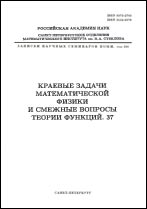|
|
Zapiski Nauchnykh Seminarov POMI, 2009, Volume 373, Pages 144–156
(Mi znsl3580)
|
 |
|
 |
This article is cited in 6 scientific papers (total in 6 papers)
Quantization in discrete dynamical systems
V. V. Kornyak
Laboratory of Information Technologies, Joint Institute for Nuclear Research, Dubna, Russia
Abstract:
We consider a class of discrete dynamical models allowing quantum description. Our approach to quantization consists in introduction of gauge connection with values in $n$-dimensional unitary representation of some group (of internal symmetries) $\Gamma$ – the elements of the connection are interpreted as amplitudes of quantum transitions. The standard quantization is a special case of this construction – Feynman's path amplitude $\mathrm e^{i\int Ldt}$ can be interpreted as parallel transport with values in (1-dimensional) fundamental representation of the group $\Gamma=\mathrm U(1)$. If we take a finite group as the quantizing group $\Gamma$, all our manipulations – in contrast to the standard quantization – remain within the framework of constructive discrete mathematics requiring no more than the ring of algebraic integers. On the other hand, the standard quantization can be approximated by taking 1-dimensional representations of large enough finite groups.
The models considered in this paper are defined on regular graphs with transitive groups of automorphisms (space symmetries). The vertices of the graphs take values in finite sets of local states. The evolution of the models proceeds in the discrete time. We assume that one-time-step quantum transitions are allowed only within the neighborhoods of the graph vertices. Simple illustrations are given. Essential part of our study was carried out with the help of a program in $C$ – implementing computer algebra and computational group theory algorithms – we are developing now. Bibl. – 4 titles.
Key words and phrases:
symmetries of discrete system, gauge principle, quantization.
Received: 01.03.2008
Citation:
V. V. Kornyak, “Quantization in discrete dynamical systems”, Representation theory, dynamical systems, combinatorial methods. Part XVII, Zap. Nauchn. Sem. POMI, 373, POMI, St. Petersburg, 2009, 144–156; J. Math. Sci. (N. Y.), 168:3 (2010), 390–397
Linking options:
https://www.mathnet.ru/eng/znsl3580 https://www.mathnet.ru/eng/znsl/v373/p144
|

| Statistics & downloads: |
| Abstract page: | 166 | | Full-text PDF : | 63 | | References: | 34 |
|




 Contact us:
Contact us: Terms of Use
Terms of Use
 Registration to the website
Registration to the website Logotypes
Logotypes








 Citation in format
Citation in format 
